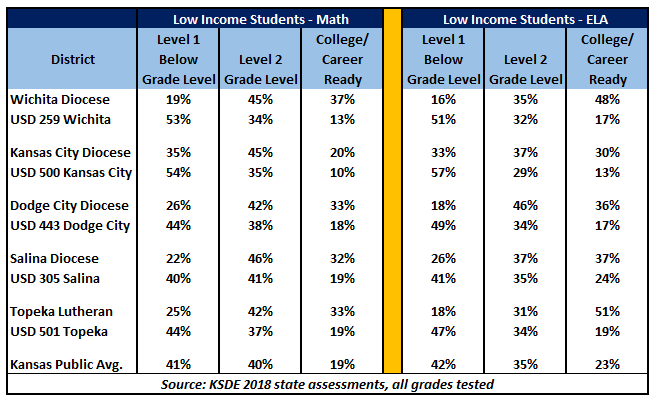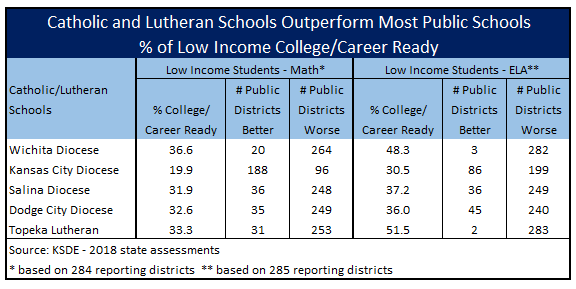With National School Choice Week (NSCW) another rousing success last month , it’s appropriate once again to show how much better private schools prepare low-income students for college/career readiness than Kansas public schools. Results from the 2018 state assessments for each of the five areas listed in the table (Wichita, Kanas City, Dodge City, Salina, and Topeka) reveal:
-> A much higher percentage of low-income students – those who qualify for free or reduced lunches – are considered college/career ready.
-> The results are similar for both math and English language arts (ELA).
-> In those same areas, private schools have a much lower rate of students considered below grade level.
-> Those results hold when comparing to public schools statewide.
 When comparing those private schools to all public districts the following table shows how well those schools prepare their low-income students:
When comparing those private schools to all public districts the following table shows how well those schools prepare their low-income students:
-> In math, four of the private school groups rank higher than 87% of all public school districts. For example, the Wichita Diocese would rank 21st among the 284 reporting districts.
-> In ELA, only two districts perform better than Topeka Lutheran schools; only three do better than the Wichita Diocese.
-> The Kansas City Diocese is the only group in the bottom half, and that is just in math.
 The truth is, it’s not really news that private school students outperform public school students, even when controlling for income level. These results are not much different than what KPI reported for the 2017 assessments. But it is vitally important the difference continues to be shown the light of day. Public school spending increased in the 2017-18 school year by 6.7% percent, yet low-income students fared even worse than the previous year. And as part of the Gannon ransom money provided by the Legislature, a similar amount is set for the current year, putting per-pupil spending over $14,000. At what point is the Legislature going to recognize that the amount of money doesn’t matter – contrary to what the Supreme Court falsely believes – and finally address the problem of students trapped in underperforming schools by providing more school choices – both private and public – to families who want to have greater control in their children’s education?
The truth is, it’s not really news that private school students outperform public school students, even when controlling for income level. These results are not much different than what KPI reported for the 2017 assessments. But it is vitally important the difference continues to be shown the light of day. Public school spending increased in the 2017-18 school year by 6.7% percent, yet low-income students fared even worse than the previous year. And as part of the Gannon ransom money provided by the Legislature, a similar amount is set for the current year, putting per-pupil spending over $14,000. At what point is the Legislature going to recognize that the amount of money doesn’t matter – contrary to what the Supreme Court falsely believes – and finally address the problem of students trapped in underperforming schools by providing more school choices – both private and public – to families who want to have greater control in their children’s education?




